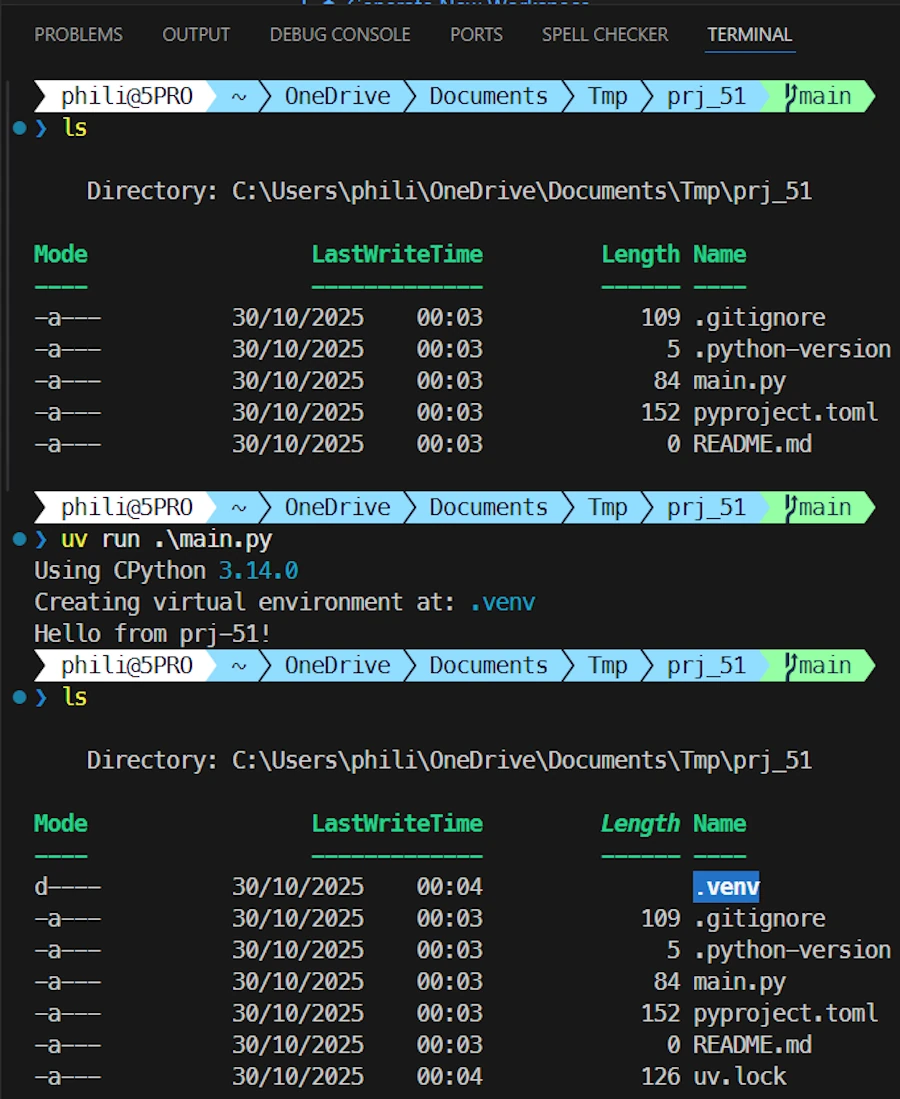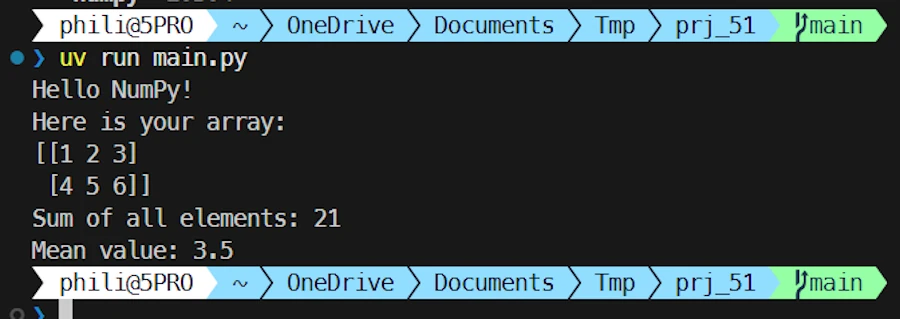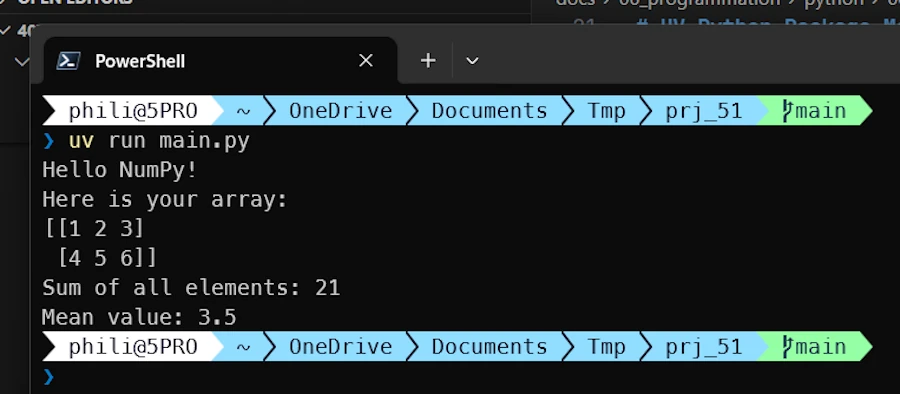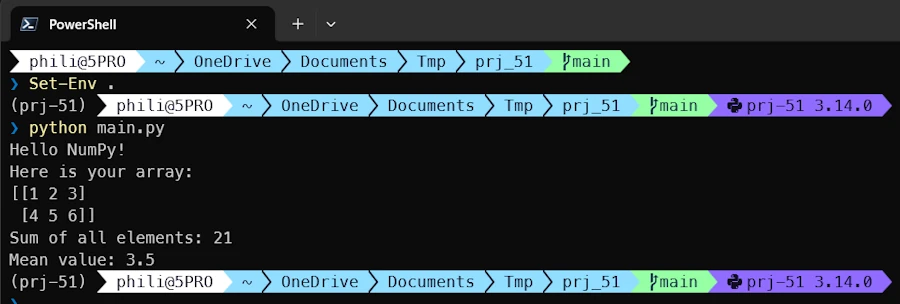
UV Python Package Manager: The Essentials
UV Python Package Manager: The Essentials
I just get rid of Conda and switch to uv. Conda was great at the beginning because it’s an all in one solution. I recommend it to beginners who just want to quickly write data = pd.read_csv.... You know the song. However conda is huge, heavy and slow. In addition while learning Rust I discovered the Cargo way of doing and I like it a lot. For example I was never using Anaconda application (not even sure of its name) but only the CLI. I should have use mini conda more often. I don’t know.
You can read these posts here:
TL;DR
uv init prj_51 --python 3.12
cd prj_51
code .
uv add numpy
# write code...
uv run main.py
# Out of VScode - Option I
uv run main.py
# Out of VScode - Option II
Set-Env . # or .venv\Scripts\activate
python main.py
- I use Windows 11 and VSCode
- Read the doc
Install
winget install astral-sh.uv
uv --version
PowerShell function for quick activation
Add this function to your Documents/PowerShell/Microsoft.PowerShell_profile.ps1 profile:
# Function to activate a venv
function Set-Env {
param([string]$EnvName = $null)
# If argument is "." or no argument provided
if (($EnvName -eq ".") -or (-not $EnvName)) {
# Case 1: uv project with .venv
if (Test-Path ".\.venv\Scripts\Activate.ps1") {
& ".\.venv\Scripts\Activate.ps1"
return
}
# Case 2: Inside a folder that IS the environment (uv venv myproj then cd myproj)
if (Test-Path ".\Scripts\Activate.ps1") {
& ".\Scripts\Activate.ps1"
return
}
# Case 3: Environment in parent folder (uv venv myproj from parent)
$parentName = Split-Path -Leaf (Get-Location)
if (Test-Path "..\$parentName\Scripts\Activate.ps1") {
& "..\$parentName\Scripts\Activate.ps1"
return
}
# Otherwise search for "venv" by default
$EnvName = "venv"
}
# Search for named environment in current directory
if (Test-Path ".\$EnvName\Scripts\Activate.ps1") {
& ".\$EnvName\Scripts\Activate.ps1"
}
# Search for named environment in parent directory
elseif (Test-Path "..\$EnvName\Scripts\Activate.ps1") {
& "..\$EnvName\Scripts\Activate.ps1"
}
else {
Write-Host "Environment '$EnvName' not found" -ForegroundColor Red
}
}
Episode IV: A New Hope
uv init prj_51
cd prj_51
code .
CTRL + ù
uv run main.py
A .venv is created

uv add numpy

Now pyproject.toml looks like this:
[project]
name = "prj-51"
version = "0.1.0"
description = "Add your description here"
readme = "README.md"
requires-python = ">=3.14"
dependencies = [
"numpy>=2.3.4",
]
And the code looks like that:
# main.py
import numpy as np
def main():
# Create a simple 2D NumPy array
# (Think of it as a small matrix)
arr = np.array([[1, 2, 3],
[4, 5, 6]])
# Print the array
print("Hello NumPy!")
print("Here is your array:")
print(arr)
# Compute and print the sum of all elements
print("Sum of all elements:", np.sum(arr))
# Compute the mean (average) value
print("Mean value:", np.mean(arr))
if __name__ == "__main__":
main()
In VSCode console
uv run main.py

Let’s leave VSCode and let’s go back in Powershell
uv run main.py

Now, if you don’t want to use uv run main.py but you prefer to call python main.py the .env must be activated manually.
.venv\Scripts\activate
python main.py

Let’s deactivate the environment (just for the next test)
deactivate
Let’s reactivate .env manually with our Set-Env function
Set-Env .
python main.py

There is a smell of rust in the air…
uv was created by the same team that made Ruff, and they clearly drew inspiration from the Rust ecosystem:
| Rust (Cargo) | Python (uv) |
|---|---|
cargo new | uv init |
cargo add | uv add |
Cargo.toml | pyproject.toml |
Cargo.lock | uv.lock |
cargo build | uv build |
cargo run | uv run |
Why this inspiration?
The Rust ecosystem is renowned for having one of the best package manager among modern languages. Python has needed this for a long time!
Before uv, we had:
pip(installer)venv(virtual environments)setuptools/poetry/pipenv(project management)pyenv(Python versions)
uv unifies all of this into a single fast tool with the same philosophy as Cargo.
The difference
Unlike Rust, where Cargo is the official tool, uv is a third-party tool that aims to modernize the Python ecosystem.
VSCode setup
Optional because VSCode may ask you the question when the project is loaded.
- Open a Python project in VSCode
- Press
Ctrl+Shift+P→ “Python: Select Interpreter” - Choose the interpreter inside the
.\Scripts\python.exefolder